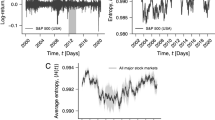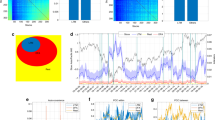Abstract
Buying and selling in financial markets is driven by demand, which can be quantified by the imbalance in the number of shares transacted by buyers and sellers over a given time interval. Here we analyse the probability distribution of demand, conditioned on its local noise intensity Σ, and discover the surprising existence of a critical threshold, Σc. For Σ < Σc, the most probable value of demand is roughly zero; we interpret this as an equilibrium phase in which neither buying nor selling predominates. For Σ > Σc, two most probable values emerge that are symmetrical around zero demand, corresponding to excess demand and excess supply1; we interpret this as an out-of-equilibrium phase in which the market behaviour is mainly buying for half of the time, and mainly selling for the other half.
Similar content being viewed by others
Main
We use the Trade and Quote database to analyse each and every transaction of the 116 most actively traded stocks in the two-year period 1994–95. We quantify demand by computing the volume imbalance, Ω(t), defined as the difference between the number of shares, QB, traded in buyer-initiated transactions and the number, QS, traded in seller-initiated transactions in a short time interval, Δt (refs 2, 3).

where i = 1,...,N labels each of the N transactions in the time interval Δt, qi denotes the number of shares traded in transaction i, and ai = ±1 denotes buyer-initiated and seller-initiated trades, respectively2.
We also calculate, for the same sequence of intervals, the local noise intensity, Σ(t) ≡ 〈|qiai − 〈qiai〉|〉, where 〈...〉 denotes the local expectation value, computed from all transactions of that stock during the time interval Δt.
We find (Fig. 1a) that for small Σ, the conditional distribution, P(Ω|Σ), is single-peaked, displaying a maximum at zero demand, Ω = 0. For Σ larger than a critical threshold, Σc, the behaviour of P(Ω|Σ) undergoes a qualitative change, becoming double-peaked with a pair of new maxima appearing at non-zero values of demand, Ω =Ω+, and Ω =Ω−, which are symmetrical around Ω = 0.
a, Conditional density, P(Ω|Σ), for varying Σ computed using data for all stocks. For each stock, Ω and Σ are normalized to zero mean and unit first centred moment. The distribution has a single peak for Σ < Σc (solid line). For Σ ≈ Σc(dotted line), the distribution flattens near to the origin, and for Σ < Σc, P(Ω|Σ) displays two peaks (dashed line). b, Order parameter Ψ (positions of the maxima of the distribution P(Ω|Σ)) as a function of Σ. For small Σ, P(Ω|Σ) displays a single maximum, whereas for large Σ, two maxima are present. To locate the extremes as accurately as possible, we compute all probability densities using the density estimator of ref. 8. Also shown (by shading) is a phase diagram representing the two distinct market phases. Here, Δ t = 15 min; our results hold for Δ t ranging from 15 min up to about half a day, beyond which our statistics are insufficient.
Our findings for the financial-market problem are identical to what is known to occur in all phase-transition phenomena, wherein the behaviour of a system undergoes a qualitative change at a critical threshold, Kc, of some control parameter K. The change in behaviour at Kc can be quantified by an order parameter Ψ(K), where Ψ(K) = 0 for K < Kc, and Ψ(K) ≠ 0 for K > Kc.
For the financial-market problem, we find that the order parameter Ψ = Ψ(Σ) is given by the values of the maxima of Ω± of P(Ω). Figure 1b shows that the change in Ψ(Σ) as a function of Σ is described by

We interpret these two market phases as corresponding to the following two distinct conditions of the financial market.
First is the 'Σ < Σc' market phase, in which the distribution of demand, Ω, is single-peaked, with the most probable value being zero; we interpret this to be the market equilibrium phase, because the price of the stock is such that the probability of a transaction being buyer-initiated is equal to the probability of a transaction being seller-initiated4. In the equilibrium phase, there is statistically no net demand, and prices fluctuate around their 'equilibrium' values, suggesting that most of the trading is due to 'noise' traders who trade from misperceived information or for idiosyncratic reasons5,6,7.
Second is the 'Σ > Σc' market phase, in which the distribution of demand is bimodal. We interpret this to be the out-of-equilibrium phase, because the price of the stock is such that there is an excess of either buyers or sellers and there is a non-zero net demand for stock. Thus, in the out-of-equilibrium phase, the prevalent 'equilibrium' price has changed, so the stock price is now being driven to the market's new evaluation of a fair value, which is consistent with the possibility that most of the trading arises from informed traders who possess superior information5,6,7.
Our findings suggest that there is a link between the dynamics of a human system with many interacting participants (the financial market) and the ubiquitous phenomenon of phase transitions that occur in physical systems with many interacting units. Physical observables associated with phase transitions undergo large fluctuations that display power-law behaviour, so our results raise the possibility that volatile market movements and their empirically identified power-law behaviour are related to general aspects of phase transitions.
References
Takayasu, H. & Takayasu, M. Physica A 269, 24–29 (1999).
Lee, C. M. & Ready, M. J. J. Finance 46, 733–746 (1991).
Plerou, V., Gopikrishnan, P., Gabaix, X. & Stanley, H. E. Phys. Rev. E 66, 027104[1]–027104[4] (2002).
O'Hara, M. Market Microstructure Theory (Blackwell, Cambridge, 1995).
Black, F. J. Finance 41, 529–538(1986).
Shleifer, A. Inefficient Markets: An Introduction to Behavioral Finance (Oxford Univ. Press, New York, 2001).
Lux, T. & Marchesi, M. Nature 397, 498–500 (1999).
Holy, T. E. Phys. Rev. Lett. 79, 3545–3548 (1997).
Author information
Authors and Affiliations
Corresponding author
Ethics declarations
Competing interests
The authors declare no competing financial interests.
Additional information
brief communications is intended to provide a forum for both brief, topical reports of general scientific interest and technical discussion of recently published material of particular interest to non-specialist readers. Priority will be given to contributions that have fewer than 500 words, 10 references and only one figure. Detailed guidelines are available on Nature's website (http://www.nature.com) or on request from nature@nature.com.
Rights and permissions
About this article
Cite this article
Plerou, V., Gopikrishnan, P. & Stanley, H. Two-phase behaviour of financial markets. Nature 421, 130 (2003). https://doi.org/10.1038/421130a
Issue Date:
DOI: https://doi.org/10.1038/421130a
This article is cited by
-
Multifractal analysis of social media use in financial markets
Journal of the Korean Physical Society (2022)
-
New approaches in agent-based modeling of complex financial systems
Frontiers of Physics (2017)
-
A New Method For Dynamic Stock Clustering Based On Spectral Analysis
Computational Economics (2017)
-
Cascades on a stochastic pulse-coupled network
Scientific Reports (2014)
-
Information and phase transitions in socio-economic systems
Complex Adaptive Systems Modeling (2013)
Comments
By submitting a comment you agree to abide by our Terms and Community Guidelines. If you find something abusive or that does not comply with our terms or guidelines please flag it as inappropriate.




